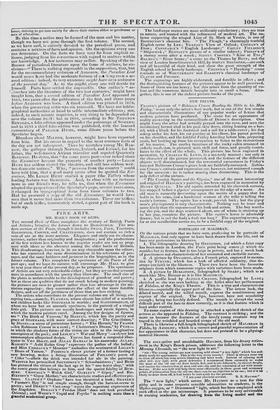NEW PRINTS.
PRA SER'S picture of "Robinson Crusoe Reading the Bible to his Man Friday," is not only the artist's best work, but is one of the few simple and characteristic illustrations of our popular works of fiction that modern painters have produced. The scene has an appearance of reality answering to the verisimilitude of DEFOE'S description. One might fancy the artist had actually peeped into the cave, and seen the involuntary hermit clad in his goat-skin dress, sitting leaning on a bar- rel, with a block for his footstool and a sail for a table-cover ; his dog asleep under his feet, his eat purring at his elbow, his parrot perched on his shoulder, and the faithful Friday kneeling before him, preparing grain, but looking up from his occupation to listen to the instructions of his master. The motley furniture of the rocky cabin arranged in orderly confusion, is pictured with skill and force, and greatly contri- butes to the effect of the whole. This picture has been engraved in mezzotint, by CHARLES G. LEwis, in u masterly manner : not only is the character of the picture preserved, and the texture of the different objects well discriminated, but the reverential earnestness in Friday's time and Robinson Crusoe's grave look are faithfully conveyed. Robin- son Crusoe's attitude and expression are, however, not animated enough for the occasion : he is rather musing than discoursing. This is the only defect of the picture. " The Country Squire and the Gipsies," one of the most interesting and original of HANCOCK'S paintings, has been engraved in mezzotint by HENRY Qcrr.i.Ev. The old squire, attended by his clownish servant, has stopped before a gipsies encampment on the edge of a moor. An old man is earnestly descanting upon the merits of a puppy that he holds in his arms, and a handsome woman of the tribe is telling the rustic's fortune. The squire has a weak, peevish look ; but the gipsy man's physiognomy is very characteristic. Nothing can be truer and more lively than the eagerness of his look and action. The boy watch- ing the pot, and the dogs scattered about, one of whom is straining up to her pup, complete the picture. The squire's horse is admirably drawn ; but is not the body a leelle too long? The engraving seems, as for as our recollection serves us, to be a faithful copy of the original


























 Previous page
Previous page